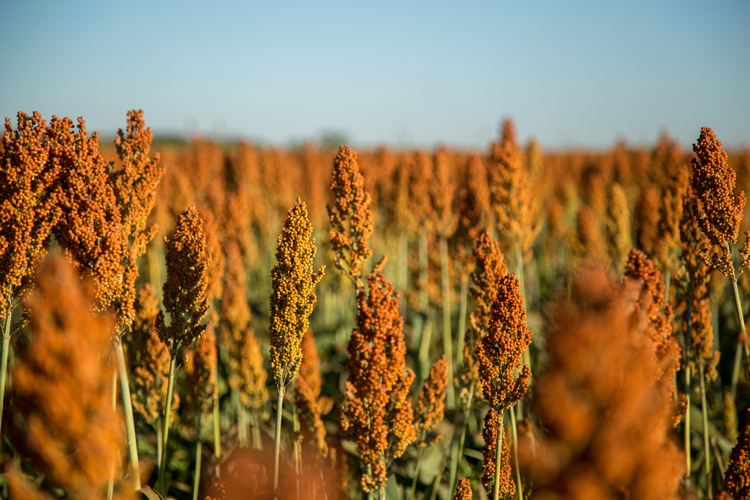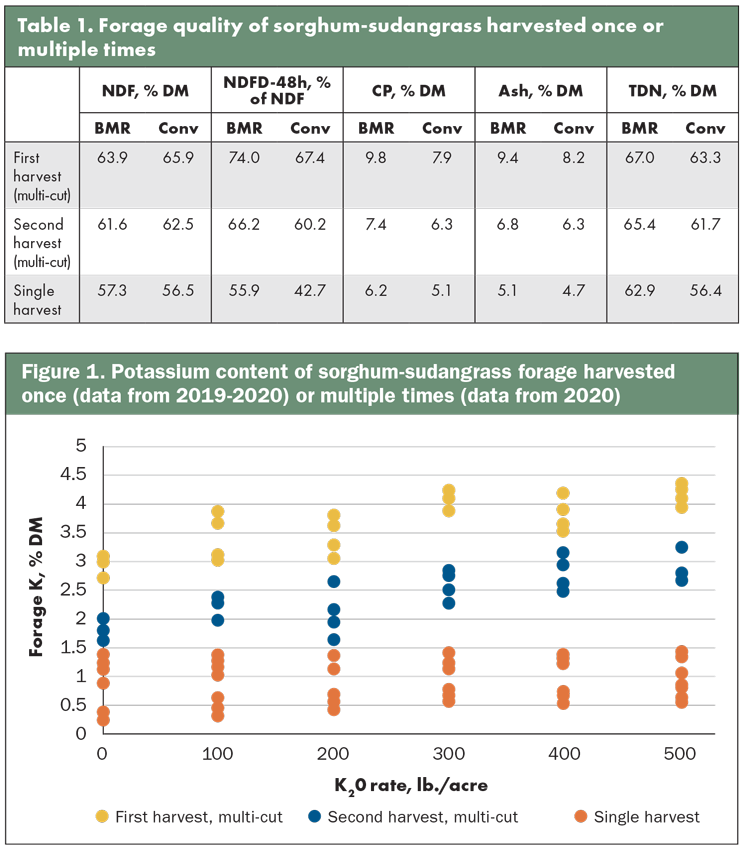Sorghum-sudangrass versatility |
| By Matt Atkins |
|
|
|
The author is a dairy scientist at the U.S. Dairy Forage Research Center in Marshfield, Wis.  As part of annual crop rotation systems, sorghum-sudangrass has become more widely used by dairy and beef producers who are looking for moderate to good-quality forage with good yield potential when managed properly. For sorghum-sudangrass, effective management to encourage fast growth encompasses several aspects, such as avoiding planting on low, poorly drained areas; ensuring a soil temperature above 60°F at planting; planting at a depth of 0.5 to 1 inch, depending on soil type; and a good soil fertility program. Forage quality of sorghum-sudangrass is primarily driven by fiber content, digestibility, and sugar content, with low grain and starch content even at advanced maturities. Harvest management is the main factor of forage quality that farms can modify to optimize sorghum-sudangrass feed value needed for intended animal groups. It also has a large effect on yield across multiple harvests, which each typically yield 1 to 2 tons of dry matter per acre, whereas a single harvest can yield 4 to 8 tons of dry matter per acre, depending on growing conditions. However, harvest frequency is typically determined by the land base needed for sufficient feed production and the costs of production rather than the potential use in specific animal rations.  Quality differences Harvest management affects sorghum-sudangrass quality similar to other forages with higher fiber and lower protein content as plant maturity advances. In the case of sorghum-sudangrass, though, we are either talking about a single harvest in the late summer or early fall or multiple harvests during the growing season (two to three cuts in most regions). A single harvest is optimal if farmers are looking for low- to moderate quality forage for use in dry cow or bred heifer rations. Taking multiple cuts when the crop reaches 3 to 4 feet tall provides forage that better fits in rations for young heifers and lactating cows. In fact, this forage is likely best suited for mid- to late lactation cows due to high fiber content. Based on data from central Wisconsin, single-harvest sorghum-sudangrass has lower crude protein (CP); less neutral detergent fiber (NDF), likely due to some grain fill and sugar accumulation; lower neutral detergent fiber digestibility (NDFD); and lower total digestible nutrients (TND) compared to when it is harvested multiple times. The use of a brown midrib (BMR) trait significantly improves NDFD and is recommended if farmers are considering using the forage in lactating cow or young dairy heifer rations. Table 1 is from two sites with varying soil textures. Forage grown on the site with sandy soil had 2% to 3% lower CP than forage on the site with heavier silt loam soils, likely due to nitrogen leaching from the root zone. Ash content is also expected to be greater for sorghum-sudangrass harvested multiple times due to greater mineral levels, especially potassium, so it would not be advisable to include those in close-up dry cow rations. Single-harvest sorghum-sudangrass had much lower potassium (K) and is more suited for dry cow rations. Sorghum-sudangrass harvested in October after a killing frost ranged from 0.4% to 1.5% K. When harvested twice each season, forage had 1.5% to 4.5% K, with much higher K for the first harvest due to being less mature and having lower yields. Potassium fertility (0 to 500 pounds of K20 per acre) does affect forage K, but it seems to be less critical to forage quality than harvest management (Figure 1). How to harvest When using a single harvest, sorghum-sudangrass can be tall (8 to 10 feet) and stemmy, which likely necessitates chopping to avoid significant refusals of long stems at feedout. As for timing, it is recommended to take the single harvest at one of two times. Do so either in late summer to early fall during an opportune warm and dry spell to allow two to three days for wilting, followed by chopping, or wait for forage to mature until it is 30% to 40% dry matter. Then, either direct chop sorghum-sudangrass or cut, wilt, and chop the forage. In some instances where planting is delayed, or if a photoperiod sensitive variety is used, a killing frost may be needed to initiate dry down if farmers want to direct cut. The use of a conventional hybrid without the photoperiod sensitive trait can help expedite harvest since it should be at soft to hard dough stage by early October. Selecting a hybrid with the dry stalk trait could also help reduce moisture at harvest. For multiple harvests, it is recommended to take the first cut when the crop reaches 3 to 4 feet tall, or approximately 45 days after planting. Then, allow approximately 30 days between harvests. If the first cut is delayed, this can reduce subsequent growth and forage yields. Also, raising the cutterbar to 6 inches will encourage faster regrowth compared to leaving only 3 inches of residual. In 2023, we were able to take three harvests from plots for the first time at our Hancock, Wis., site. This was thanks to well-drained soil, well-timed harvests, and excellent growing conditions. We usually target late July for first harvest, late August/early September for second harvest, and possibly third harvest in early October, with each harvest based on crop height. Regrowth after the first cut can be rapid due to ideal growing conditions in mid-summer, so ensure adequate fertility is available for fast growth with separate nitrogen applications for each harvest. On the other hand, a third harvest really depends on warm growing conditions going into early fall, with that cutting having less capacity for regrowth. Instead of taking the third harvest, some producers may decide to terminate the crop and establish a winter cereal grain forage in early fall. This article appeared in the March 2025 issue of Hay & Forage Grower on pages 12-13. Not a subscriber?Click to get the print magazine. |
